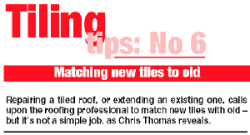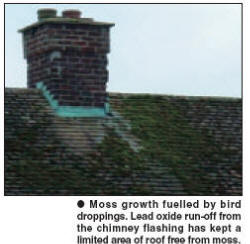 |
 |
 |
 |
 |
 |
 |
|
Check out our web directory of the UK
roofing and cladding industry
www.roofinfo.co.uk |
Sign up for our monthly news letter. |
|
|
|
|

Tiles obtained from the same
source in the same colour and finish should match exactly, but
unfortunately will not be identical, due to ingredients or temperatures
being slightly different during manufacture. The old tiles will also have
been subjected to many years of weathering from acid rain and other
atmospheric pollutants.
Identification
By looking at the area of the tile covered by the head lap, it should
be possible to identify its colour and finish. Turn the tile over to
identify the manufacturer by a mark, name or registered design number.
This number will not provide the colour reference but should give the
design and approximate age of the tile. Most modern tiles have ink jet
markings that give batch information to identify the place and date of
manufacture. From this it may be possible to obtain secondhand tiles from
a roofing or salvage merchant. Secondhand tiles will have a weathered
appearance but may still not look right as they may have been positioned
on a different facing roof slope, with more or less moss growth.
Cleaning
Another option may be to power wash the roof to remove moss, lichen
and algae. However, this may result in a patchy appearance, especially if
the tiles were granular faced. Where lichen has grown, levels of acidity
will have been greater, causing the cement slurry to erode quicker,
resulting in a greater surface granule loss.
Power washing can also force water and
debris in joints and interlocks further under the tiles, or push it onto
the underlay where it will become a problem at a later date. At worst,
water forced through laps and interlocks will run down the underlay and
may show itself inside the roof where there are holes in the underlay or
where there is a lack of tilt fillet behind the fascia board.
Clambering over the roof, even with roof
ladders and crawl boards, may result in tile breakage or the disturbance
of mortar bedding, which may not be immediately visible. Debris washed off
the roof has been known to block rain water pipes. Not only will the
gutter need cleaning, but also the down pipes and gullies. The only safe
and thorough way to clean roof tiles is to remove them, clean them and
re-fix them (only if they are not damaged).
If you suspect the tiles are made from a
material containing asbestos it may be safer to leave well alone and seek
advice from an asbestos removal expert. Prevention
At this stage it may be a good idea to treat the roof to prevent the
return of moss and lichen. This can be done in one of several ways;
position a large copper, zinc or lead flashing along all ridges and hips
and after a shower of rain a deposit of copper, zinc or lead oxide will
flow down the roof and poison moss or lichen. If the flashing is not large
enough only the area next to the ridge or hip will be protected. This
option may not be advisable if water run off is collected for watering
plants or domestic use.
|

|
| An
alternative is be to spray the roof with a biocide solution on a dry day.
This should protect it for about ten years. I am told that a strong
horticultural, or agricultural, disinfectant is just as effective
. Coating
Some clients are tempted to ask for the roof to be painted with a
pigmented coating to restore the original colour. Whilst this may make the
new and old tiles look the same, it can often look patchy due to the lack
of quality control during the application, which is difficult to achieve
in the open air. Like all coatings, they do not last forever. They will be
affected by the elements and will start to break down within a few years
and may look worse than before. Also, a build-up of the coating may
congeal in the interlocks and laps and restricts the free draining of the
roof system, especially if they have not been thoroughly cleaned.
Promoting growth
An alternative is to do the opposite; treating the new section of roof
with nutrient should encourage the growth of moss and lichen to match the
old section of roof. The nutrient could be skimmed milk/yogurt (natural
not fruit), liquid tomato fertilizer or liquid cow manure. The liquid cow
manure option is cheap but may turn the whole roof brown for a short
period of time and have a rather strong smell. The application should be
sufficient to cover the roof but not congeal in the joints and interlocks
where it may do more harm than good.
Grouping
The best solution may be to strip a section of the existing roof and
use the good salvaged tiles to cover the remainder of one elevation and
put all the new tiles on one or more complete elevations to maintain the
new or old appearance of the roof. This also has the benefit of allowing
part of the roof to maintain the tile manufacturer’s guarantee, as
laying new tiles with old tiles may invalidate a guarantee, especially if
the design of the tile has been improved and are not backwards compatible.
With clay plain tiles, thorough mixing can produce a pleasing random,
mottled appearance, but to achieve this successfully the tiles all need to
be of the same type, preferably from the same manufacturer. Mixing double
camber handmade tiles with single camber machine made tiles can look a
mess.
Whichever method is decided upon, within about ten years all sections of
the roof should be almost indistinguishable due to the gradual deposit and
effect of atmospheric pollution.
|
| Compiled by Chris Thomas, The Tiled
Roofing Consultancy, 2 Ridlands Grove, Limpsfield Chart, Oxted, Surrey,
RH8 0ST, tel 01883 724774 |
|